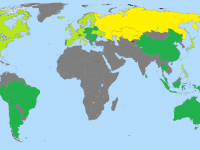Larp takes pride in creating experiences where we as players step out of ourselves and into someone else — our character — and immerse in their existence. A consequence of larping for immersion is bleed, traditionally defined as the separation between you and your character thinning, resulting in aspects of the player and the character bleeding between the two.
Emphasizing separation between player and character is useful to create alibi for acting differently as your character. However, the separation between character and player is limited by the fact that they share one body. Consequently, if you want to thin the line between yourself and your character to experience more bleed, it’s not hard to do — our brain is bad at separating them to begin with.
Why would we want to reinforce bleed? Well, why do we larp? To explore things that we might not be able to explore in our everyday life, for liberation, playing around, for personal growth? Either way, taking measures to design our own player experience can make that experience stronger. Designing your player experience includes making conscious choices, instead of reactively dealing with bleed. We all bleed when we larp, but bleed doesn’t have to be just a haphazard consequence. Bleed can also be the product of focused preparations to tailor the experience you want to have, and a tool to enhance your own immersion. We advocate proactive, rather than reactive
(or even retroactive) bleed management.
This toolbox provides practical tips on how to manipulate your brain into more bleed and more immersive experiences. You might see this as a guide for what to avoid if you hate bleed, but that’s not why we wrote it.
But how does it work?
Self-manipulation is a conscious, top-down process, where you use your cognitive, self-aware thought processes (top) to rewire brain connectivity and inform your subconscious patterns of action and reaction (bottom) — see the highly explanatory figure.
A great example of this process is cognitive therapy, where the goal is to consciously rewire harmful subconscious reactions. For instance, a person suffering from a phobia can expose themselves on purpose to situations they normally avoid. The situation triggers the unwanted alarm systems (the anxiety). They then practice behaving differently in that situation, rewiring the alarm systems to stop firing. Their conscious change of behavior alters subconscious reactions (see Craske & Mystkowski, 2006). It’s also possible to create an alarm by doing the opposite, which of course has nothing to do with therapy (but maybe larping).

Image source: Rawpixel.com
Here are two areas of character preparation where you can use your newfound knowledge about the brain’s potential for conscious self-manipulation: the bleed-oriented character builder, and the bleed-enhancing relation-building process.
The Bleed-Oriented Character Builder
When creating a character for a larp, we want to build a real, breathing person, someone that acts and reacts to their internal and external world, with a living personality. But how do you create a new, yet believable and real, personality for a character in a limited amount of time? And how do you then become that person?
Tool #1: Creating a Skewed Narrative Identity
Narrative identity is a concept within personality psychology that describes the process of taking your experiences and integrating them into an ever-evolving story with yourself as the protagonist. This story creates structure, meaning and purpose in an otherwise chaotic existence.
Creating a narrative identity for your character can be used to enhance the feeling of being that character. To understand why, you only need to know one thing: a person’s particular way of narrating their reality is a powerful predictor of well-being. The way you tell the story of your life, what you emphasize, the words you use, predicts and potentially affects how you do long-term (see Adler et al. 2016). Choose your words wisely — they have power.
Here are three simple lessons from narrative identity you can use in character creation:
- Agency: How much control over life events does your character feel they have? Are they a passive agent that things happen to, with no sense of control? Or are they an active agent that controls life events and decides how to react to them?
- Connectivity: To what extent does your character feel connected to other people, as opposed to isolated and alone?
- Purpose: How good is your character at ascribing meaning to events — especially negative events?
A character with a strong narrative sense of self will feel more real, both to yourself, and to others. It provides a coherent way to relate to your surroundings, which informs the choices you make while playing. For more impactful play, consider pushing your character’s agency, connectivity and purpose to extreme positives or negatives. If you are playing a happy character with a good outlook on life, talk about yourself as someone who makes things happen, who turns to friends when facing adversity, and make sure to designate long-term positive meaning to things that happen to you. Do the opposite if you are playing a sad, depressed, or helpless character. Describe yourself as a passive participant in life, and tell yourself that you face obstacles alone or as collateral damage. Emphasize negative life events as meaningless, without any silver linings.
Bonus bleed: Want to be really sad? Place the blame for anything that goes wrong on yourself. Not only will this make sure that other people see you as a failure, it will also subconsciously make you believe that you are indeed a failure. Going through the motions makes them feel real.
Tool #2: Exploiting the Faulty Shortcuts of Your Brain
Cognitive biases are mistakes in processes such as reasoning, evaluating, and remembering. They result from shortcuts your brain takes, like “jumping to conclusions”, in order to save time and energy.
Humans do this all the time. If you think you don’t, you’re suffering from the Bias-Bias: the tendency to see yourself as less biased than other people.
Most people consider these biases a pain, but we’d like to turn that around. In larp preparations, biases give us something to work with instead of against, and help us save time and resources building our character. And what do we not have a lot of before going to a larp? Time and resources! Because cognitive biases are an integrated part of human behavior, they form believable character portraits. They can also help you think on your feet and make decisions that feel natural for your character, resulting in more immersion.
The best thing about cognitive biases is that they reinforce themselves. In other words, by using them, you push your subconscious self toward whatever state of mind the bias is serving.
The Bleed-Enhancing Relation-Building Process
You can do a lot to influence how you see yourself as a character, but your relationships to others are just as important in the social setting of a larp.
When tricking the brain, work with clear-cut opposites. Nuance makes it harder for the brain to understand what it is supposed to do, as too much depends on circumstance. We will concentrate on the two most basic human forms of relations: attraction and repulsion.
Tool #3: Cognitive Biases for Attraction and Repulsion
Our brain makes plenty of automatic shortcuts when relating to other people:
- We think better of people we already like
- The more time we spend with someone, the more we like (or at least tolerate) them
- We see other groups as more homogenous, uninteresting, and less adaptive than our own
- We hold entire groups other than our own responsible for the actions of a single group member, while dividing negative responsibility individually within our own group
This can be exploited in your larp preparation when creating your character’s inner circle. If you don’t know the people you will play closely with, spend time with them before the larp starts. With limited time (for instance two hours before the larp starts), prioritise doing something where there’s a lot of pressure and uncertainty. Humans seek each other when exposed to stress! Fall from somewhere high and trust that the group will catch you, or go swimming in the dark after watching a shark movie.
Bonus bleed: Add any number of optional elements to the activities that further increase adrenaline levels, like putting on a blindfold, being naked, telling each other scary stories in the dark, or teaming up with someone random to jump out from the woods. The last one has an extra bonus — having a common enemy strengthens in-group bonding!
Tool #4: Bodily Strategies for Attraction and Repulsion
Remember that thing you ate once that made you sick, that you were never able to eat again? Or Pavlov’s famous experiment where he used a bell to prime dogs to expect feeding, where they eventually salivated just from the sound of the bell? Same thing. Physical memory is powerful.
Conditioning is the process of associating one thing with another thing by repeated consecutive exposure, creating a reflex response. Bell means food means saliva. Why not do the same for larp relations? Try looking at a picture of your character’s enemy whenever you’re stressed or dealing with something unpleasant — like when you are hangry or hungover.
Bonus bleed: If you really want to exploit the mysteries of your body to create a deeper experience, why not use all the tools, including the hormonal fluctuations of your menstrual cycle?
Self-reported observations from groups of women show that the week before menstruation comes with higher physical stress and less interest in erotic subjects. The mid-cycle, especially between menstruation and ovulation, triggers more positive affiliations towards others, higher interest in erotic subjects, greater well-being, better mood, and general awesomeness. This might affect male co-players as well — men seem to like women a lot when they are ovulating. Why not let this influence the timing of when you meet other players, if logistics cooperate?
Tool #5: Engage All Your Senses
Smell your co-players. Humans favor the scent of people who are genetically different from ourselves (thank you, evolution and reproduction). If you play close relationships with players whose smell you prefer, your brain will help you like them more. If you want your character to repulse other players, surround yourself in smells that our brains are wired to react negatively to, like rotten or spoiled food (thanks again, evolution). There are less intrusive versions of this, like opening a can of surströmming (fermented baltic herring) or eating lots of garlic (with obvious extra benefits if you’re playing a human at a vampire larp).
Touch your co-players. If you want to feel good during a larp and to create that feeling together with someone else, touch them. Holding hands, hugging, or just touching someone’s arm or shoulder will suffice. If you’re a designer and want to create a feeling of alienation and distrust, ban all touching. People will be sad.
Tool #6: Fast Tracking Emotional Bonding
Feeling physically close to someone is a powerful part of feeling attraction. But if you’re looking to get to the romantic side of things, you’ll want to feel emotionally close too. A feeling of shared knowledge plays a huge part in emotional closeness. We suggest using the 36 questions from the study on generating interpersonal closeness (see Aron et al. 1997), as these are questions that have been shown to create a common sense of intimacy and closeness.
Bonus: Overall Bleed-Enhancing Strategies!
If you have time to work with (not unlikely, given the trend of larp sign-ups a year in advance), start using these strategies in advance. Giving yourself practice time provides your brain with more time to realise that “ok, this is what my life looks like now,” making it even harder for your brain to separate between who you are, and who your character is.
There is also one simple, available strategy for enhancing all physical and cognitive experiences: Sleep deprivation. Sleep deprivation efficiently reduces cognitive inhibition — it makes you more impulsive. It also strips away your brain’s ability to filter input from your surroundings: everything matters, everything is important. This is great for emotional chaos, and for larping intense, Nordic scenarios.
Where to Go From Here?
The world we experience comes from the inside out, not just the outside in. The way we think and act affects how we feel, in life and in larp. Some level of bleed is unavoidable — it is our choice whether we want to be passive bleed recipients or treat it like a skill that can be trained. By changing our behavior consciously, we can experience almost anything we’d like — and confuse the brain into even more bleed. Is it a good idea? Maybe. We’ll leave that up to you.
Bibliography
Michelle G. Craske & Jayson L. Mystkowski (2006): Exposure therapy and extinction: Clinical studies. In M. G. Craske, D. Hermans, & D. Vansteenwegen (eds.), Fear and learning: From basic processes to clinical implications. American Psychological Association.
Jonathan M. Adler, Jennifer Lodi-Smith, Frederick L. Philippe & Iliane Houle (2016): The Incremental Validity of Narrative Identity in Predicting Well-Being. Personality and Social Psychology Review, 20(2).
Arthur Aron, Edward Melinat, Elaine N. Aron, Robert Darrin Vallone & Renee J. Bator (1997): The experimental generation of interpersonal closeness: A procedure and some preliminary findings. Personality and Social Psychology Bulletin, 23(4).
Tova Gerge & Gabriel Widing (2006): In T. Fritzon, & T. Wrigstad (eds.), Role, Play, Art.
Can’t be bothered to Google cognitive biases? Look no further! https://en.wikipedia.org/wiki/List_of_cognitive_biases
Author note: Additional technical citations are available, but have been omitted for space.






